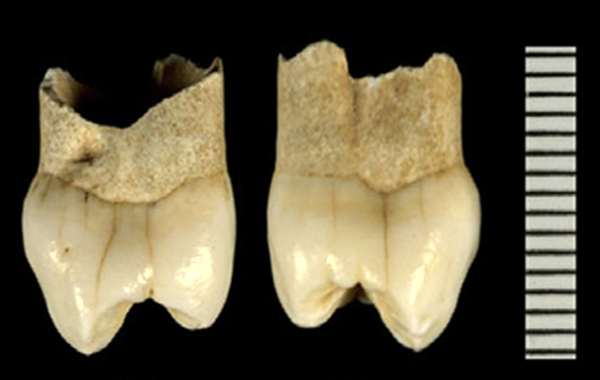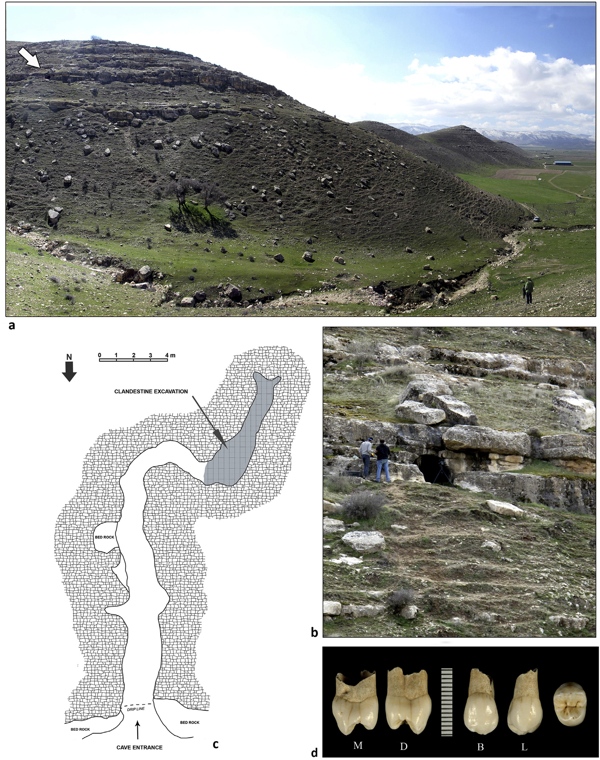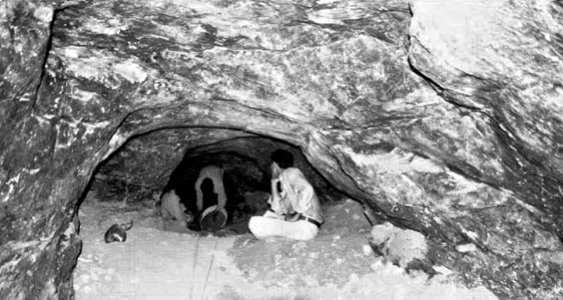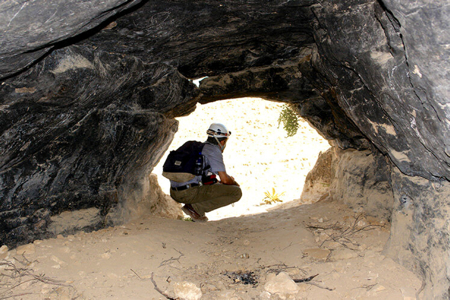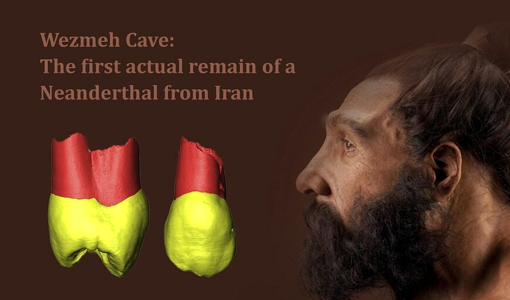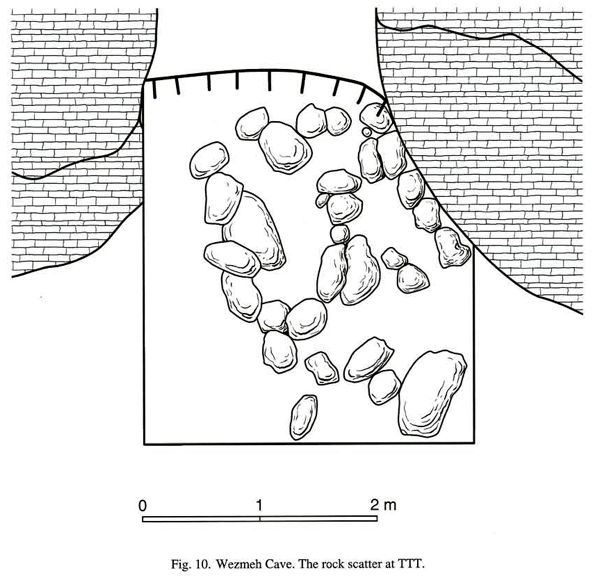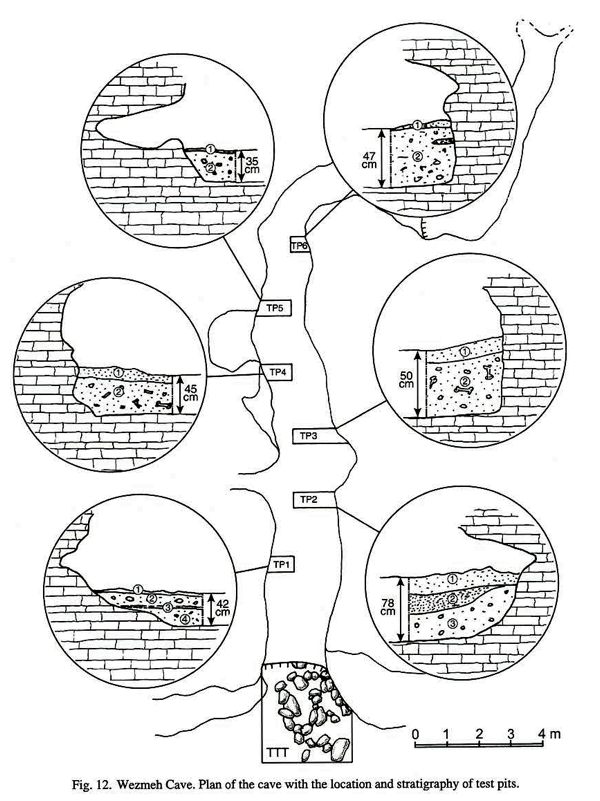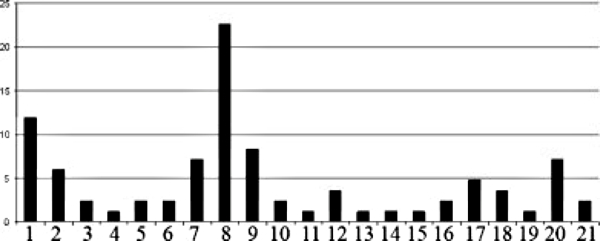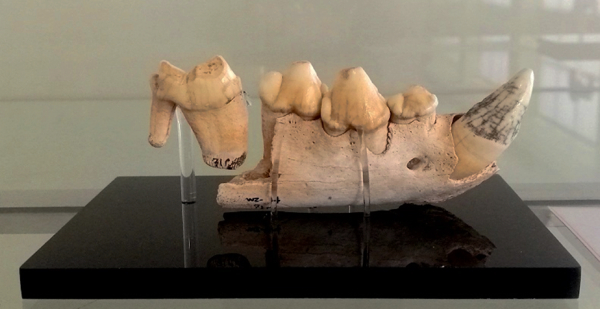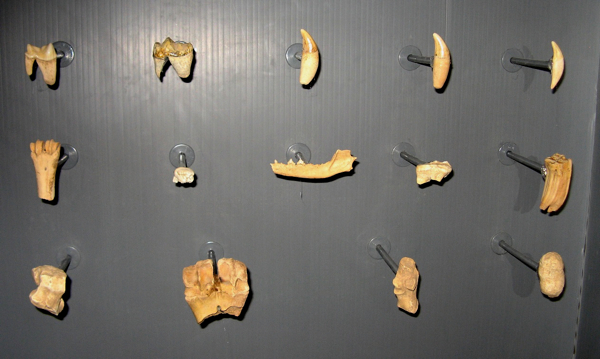Back to Don's Maps
 Mousterian (Neanderthal) Sites
Mousterian (Neanderthal) Sites Back to the review of hominins
Back to the review of hominins
Neanderthal child from Wezmeh Cave
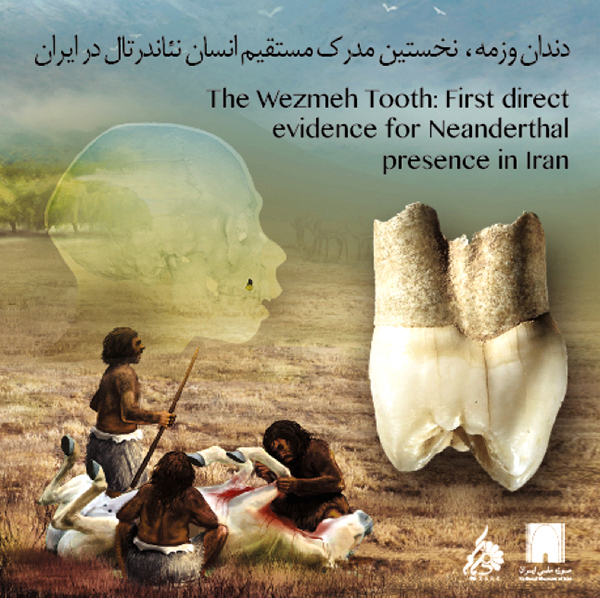
Stamp issued by National Museum of Iran featuring the Wezmeh Neanderthal tooth.
Source: Courtesy Fereidoun Biglari, Head of the Palaeolithic Unit of the National Museum of Iran
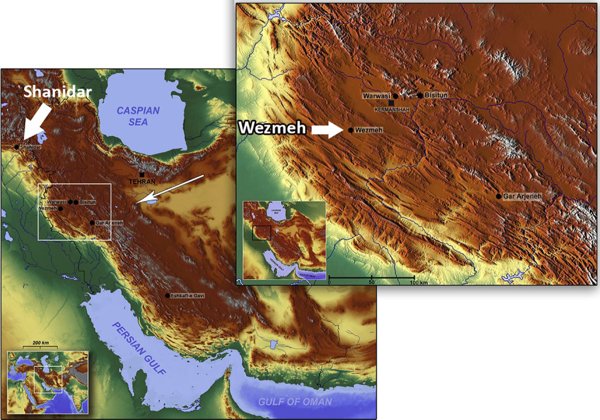
Location of Wezmeh Cave.
Photo:
Zanolli et al. (2019)
Wezmeh Cave was recorded during the second season of survey of the Islamabad Plain in 1999. The most remarkable feature at the site was a heap of debris in and around the cave mouth and on the slope leading to the cave as may be seen in the photograph.
According to the locals, the cave deposits were partially dug out in 1995 by clandestine diggers in a futile search for ancient artefacts. Our inspection suggested that the area targeted by clandestine diggers was towards the middle and rear sections of the cave, particularly the latter where in some places five metres of deposits were removed and dumped further upfront and on the slope in front of the cave mouth.
A brief inspection of the back-dirt produced a considerable amount of faunal material, especially bones of large carnivores, as well as ruminants and other wild animals. In the debris we also found a flake core and a simple flake, and a handful of pot-sherds, including examples of Coarse Chaff-tempered Buff Ware and Coarse Chaff-tempered Burnished Red-Slipped Ware and a single piece of painted Black-on-Buff ware, all typical of the Early to the Middle Chalcolithic (Copper Age, circa 4000 - 2000 BC) period of the region.
We recorded the Wezmeh Cave as ID87, a possible carnivore den with ephemeral human occupation during the Middle Chalcolithic period.
Text above adapted from:
Abdi et al. (2001)

General view of Wezmeh cave looking south. Note the debris dug from the cave and dumped on the slope by clandestine diggers.
Photo and text adapted from:
Abdi et al. (2001)
Unerupted Neanderthal maxillary right premolar tooth (P3 or possibly P4) of an individual between 6 – 10 years old from Wezmeh Cave.
In a recent study, Biglari said the specimen, originally thought to be from a modern human, was re-analysed by Roberto Macchiarelli and Clement Zanolli by X-ray micro-CT imaging that revealed the inner structure of the tooth, especially the enamel-dentine junction, which aligns the tooth closely with Neanderthals and shows that it is distinct from modern humans. He added, therefore, this tooth is the first direct evidence of the Neanderthal presence in the Iranian Zagros.
Photo: Hiarash
Permission: Creative Commons Attribution-Share Alike 4.0 International license.
Text: https://ut.ac.ir/en/news/9858/fossilized-tooth-is-first-evidence-neanderthals-once-lived-in-iran
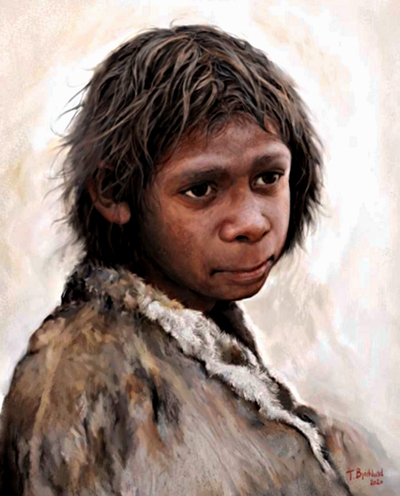
Painting of a 9 year old Neanderthal child by Tom Björklund.
Painter: Tom Björklund
Permission: Creative Commons Attribution-Share Alike 4.0 International licence
Given that the cave was a carnivore den during late Pleistocene, it is probable that the Wezmeh Child was killed, or had its remains scavenged, by carnivores who used the cave as a den. Within an approximate 30 km radius of the Cave, 13 Middle Palaeolithic sites have been recorded; among them, the nearest sites are located about 10 km to the northwest. The tooth is on display at the Palaeolithic gallery of the National Museum of Iran.
Text above: Wikipedia
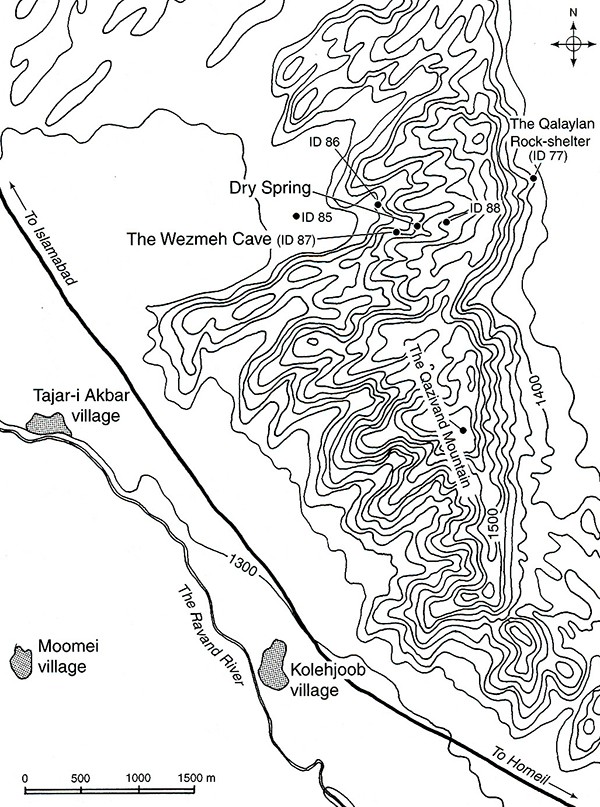
Qazivand Mountains. Map showing the location of the Wezmeh Cave.
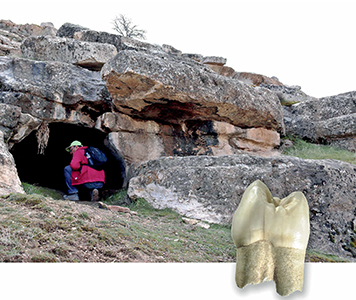
View of the cave entrance, and (superimposed) the Neanderthal premolar found in the cave.
Photo and text: Biglari et al. (2021)
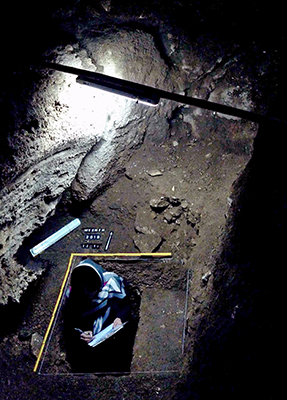
Test excavation at the rear shaft of the Wezmeh Cave.
Photo and text: Biglari et al. (2021)
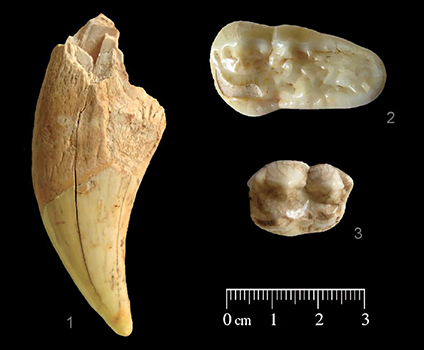
Selected faunal remains from Wezmeh Cave
Brown bear (Ursus arctos):
1 canine.
2-3 molar tooth.
Photo and text: Biglari et al. (2021)
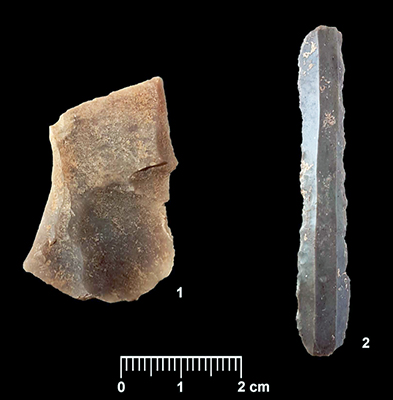
Selected lithic artifacts from Wezmeh Cave:
1 Flake with dihedral platform.
2 Bladelet with steep and continuous retouch.
Photo and text: Biglari et al. (2021)
The Natural Setting
Wezmeh Cave is located at N34°03'20" and E46°38’42", about 12 km to the southeast of the town of Islamabad-i Gharb and 3.5 km to the northeast of the village of Tajar-i Akbar. The cave is located in a small side valley tucked into the west foothills of Qazivand Mountain.
Qazivand is the southwest side of an unroofed (eroded) anticline, reaching a maximum height of 1558 m a.s.1. on a north-south axis, overlooking to the east the Shiyan and to the west the Islamabad Plains. Wezmeh Cave is located at an elevation of 1430 m a.s.1. about 60 m above the valley floor on a steep slope with a dip of 36°. The mouth of the cave faces north and is 2m wide and 1.2 m high.
The cave is about 27 m long and has an area of about 45 m2 The front-most 12 m of the cave is relatively straight. This section has a low ceiling, only up to 80 cm high in some places. At about 15 m from its mouth, the cave makes a sharp turn towards the west and extends for about 5 m in which the height of the ceiling gradually increases. The floor of this section also has a 13° slope. This section of the cave extends for 5 m and then makes a turn towards the southwest and extends for another 7 m with a steep slope.
The closest source of water to the Wezmeh Cave used to be a spring about 200 m to the east, but this spring has long ago dried up. However, a cluster of a few elm trees (wezm in the local Kurdish dialect; hence the name Wezmeh) around where the spring used to emerge suggests some underground water supplies. Nowadays, the closest source of water is the Ravand River about 4 km to the southwest of the cave.
Wezmeh Cave is in fact a solution feature within the Asmari Limestone Formation that forms the slopes of Qazivand Mountain. The cave is not located in an active karst zone, but rather in a relatively arid area. However, one can see a layer of calcium carbonate created by semi-active flowstones, particularly towards the rear of the cave. It appears that prior to clandestine excavations in the cave, the rear section was filled with sediments, in places 4 to 5 metres deep.
These deposits, which represent thousands of years of sedimentation, can be attributed to a combination of the following processes:
(1) sediments carried by water through cracks and cavities in the cave’s walls and ceiling. In the plateau above the cave there is an open area amenable to sheetwash movements during rainy season,
(2) weathering process and pedogenesis during climatic oscillations,
(3) decomposition of floral and faunal material, or
(4) wind blown silt and sand.
In terms of texture, colour, and morphological characteristics, the debris left by clan- destine diggers is similar to sediments encountered in test excavations. Macroscopic comparisons of the debris from the rear section of the cave with those from test excavations is presented in Table 1. However, it should be noted that the latter is lighter in colour and has some morphologic features including chalky nodules, predominantly less than 3 cm in diameter.
Photo and text adapted from: Abdi et al. (2001)
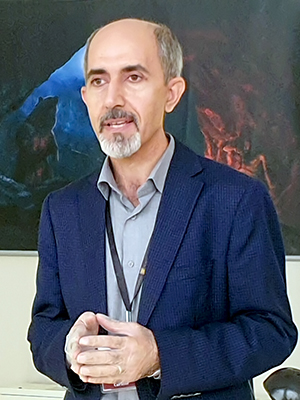
Fereidoun Biglari, presenting a virtual tour of Wezmeh Cave, at the Palaeolithic gallery of the National Museum of Iran, November 2020.
Fereidoun Biglari is the co-founder and head of the Palaeolithic department in the National Museum of Iran which was established in 2001. He is a member of the research council of the Iranian Center for Archaeological Research (ICAR). He is also editor-in-chief of the 'Journal of Iranian Archaeology' since its establishment in 2010. The journal is a scholarly journal about ancient Iran and neighbouring regions. Since 1993, he has been directing archaeological field projects in various parts of Iran. His field of research covers the Lower Palaeolithic of Iran and western Asia and the Middle Paleolithic of Iran in general and the Zagros region (Iran and Iraq) in particular.
Photo: Nina Rezaei
Permission: Creative Commons Attribution-Share Alike 4.0 International licence
Text: Wikipedia
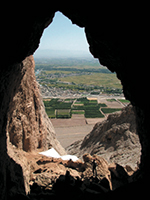
Readers may be interested in this short introduction by Fereidoun Biglari to the archaeology of Iran.
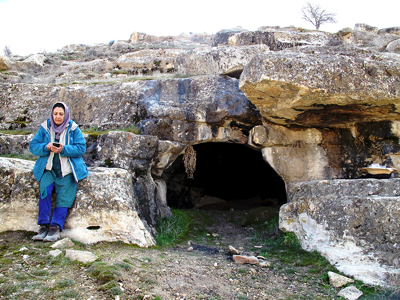
Wezmeh Cave, with Dr Marjan Mashkour at the entrance.
Dr Mashkour is the first Iranian to specialise in the field of zooarchaeology and has been engaged in many field and laboratory projects in Iran and the Near East.
Photo: Courtesy Fereidoun Biglari, Head of the Palaeolithic Unit of the National Museum of Iran
Additional text: Wikipedia
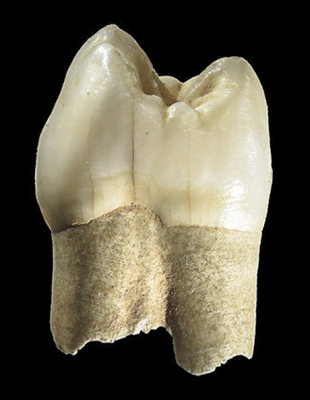
The Neanderthal premolar unearthed in Wezmeh Cave.
Photo: Nima Fakourzadeh/National Museum of Iran
Source: https://www.atlasobscura.com/articles/found-neanderthal-tooth-cave-iran
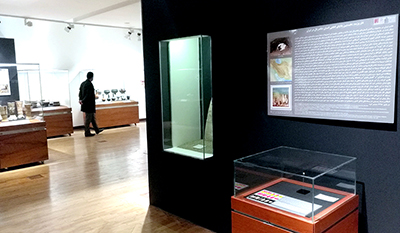
The Wezmeh Neanderthal tooth on display in a temporary exhibition at the National Museum of Iran- February 2020.
Photo: Courtesy Fereidoun Biglari, Head of the Palaeolithic Unit of the National Museum of Iran
Photo: Zanolli et al. (2019)
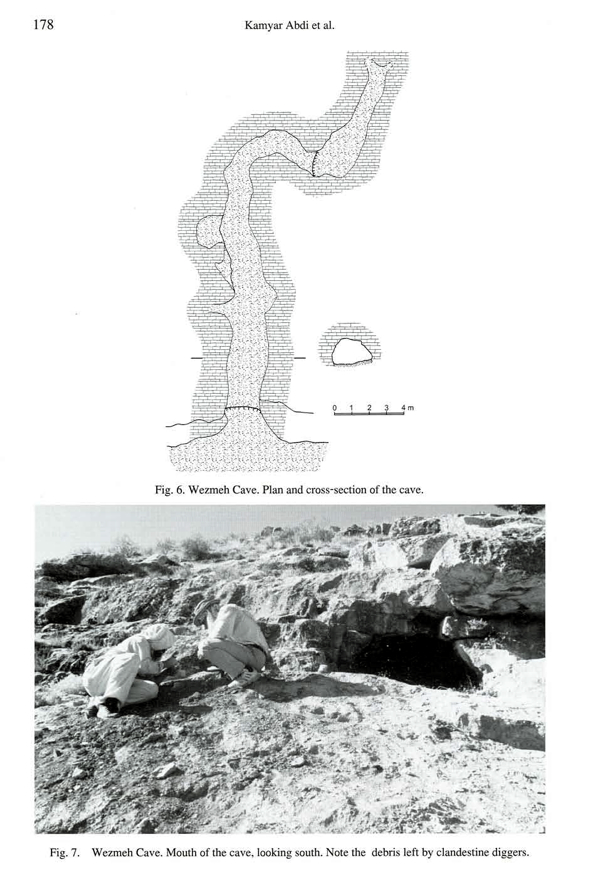
Plan and photo of the exterior of Wezmeh Cave.
We continued our probe of the debris all the way up to the relatively flat area before
the cave mouth, where we opened an exploratory 3 x 3 m trench called T(hreshold) T(est)
T(rench). We excavated at TTT, the Threshold Test Trench, to a depth of about 70 cm, clearing the area from back dirt that contained some bones and a total of 12 sherds and 2 lithic artifacts.
Photo and text adapted from:
Abdi et al. (2001)
Inside the cave, low ceiling of the middle section.
Photo and text adapted from:
Abdi et al. (2001)
Entrance of Wezmeh Cave, view from inside.
Source: https://www.tehrantimes.com/news/439349/Iran-among-countries-with-Neanderthal-discoveries
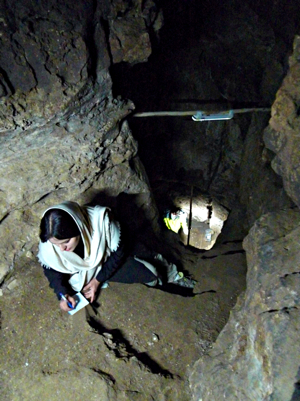
Recent excavations (2019) at Wezmeh Cave.
The archaeologist shown is Dr Sonia Shidrang.
Dr Shidrang has led several field projects in the Central Western Zagros and recently has initiated a fieldwork project in the Southern Zagros to compare the Middle and Upper Palaeolithic sequences in different regions of this Iranian mountain range.
In her research, she attempts to understand the patterns of human behaviour in Late Pleistocene settlements of the Zagros Mountains, particularly in the Middle to Upper Palaeolithic transition and the beginning of Upper Palaeolithic, through the study of different aspects of lithic artefacts.
Photo: Courtesy Fereidoun Biglari, Head of the Palaeolithic Unit of the National Museum of Iran
Text: Adapted from https://conversationsinhumanevolution.wordpress.com/2020/08/11/conversations-with-dr-sonia-shidrang/
A new find, recently published in the Journal of Human Evolution, suggests that Neanderthals were roaming at the Iranian Zagros Mountain sometime between 40 to 70 thousand years ago.
Source: https://www.tehrantimes.com/news/439349/Iran-among-countries-with-Neanderthal-discoveries
Further beneath the back dirt we found a concentration of rocks scattered around in the general area of the cave mouth. This scatter of rocks is particularly interesting. Our local workers believe that this scatter may have been the remains of a collapsed dry wall built by people to block the cave mouth and to protect them and their animals inside from approaching carnivores.
Another argument put forward by our workers was that the rocks may, again, be remains of a dry wall, build by people to seal the cave in order to asphyxiate, by burning wood and bushes, wolves that had attacked their flock and might have been hiding in the cave. This proposition may find some support in soot-covered cave walls.
Photo and text adapted from:
Abdi et al. (2001)
Photo and text adapted from:
Abdi et al. (2001)
| Carnivores and Prey in Wezmeh Cave NISP = number of identified specimens MNI = minimum number of individuals |
|||
|---|---|---|---|
| Species | Common Name | NISP | NMI |
| Carnivora | |||
| Crocuta crocuta | Spotted hyena | 437 | 10 |
| Ursus arctos | Brown bear | 192 | 5 |
| Panthera leo | Lion | 16 | 2 |
| Panthera pardus | Leopard | 2 | 1 |
| Caracal/Lynx/Felis | Caracal/lynx/jungle cat | 4 | 2 |
| Felis silvestris | Wildcat | 8 | 2 |
| Canis lupus | Wolf | 176 | 6 |
| Vulpes vulpes | Red fox | 492 | 19 |
| Meles meles | Badger | 42 | 7 |
| Mustela putorius | Polecat | 7 | 2 |
| Martes martes (foina?) | Stone marten | 2 | 1 |
| Herpestes sp. | Mongoose | 5 | 3 |
| Primate | |||
| Homo sp. | Human | 1 | 1 |
| Perissodactyla (horses, asses, and zebras, the tapirs, and the rhinoceroses) | |||
| Dicerorhinus | Rhinoceros | 2 | 1 |
| Equus caballus | Horse | 1 | 1 |
| Equus hemionus / Equus asinus | Onager / donkey | 4 | 1 |
| Artiodactyla (cloven-hooved mammals) | |||
| Bos primigenius | Aurochs | 13 | 2 |
| Sus scrofa | Wild boar | 97 | 4 |
| Cervus elaphus | Red deer | 59 | 3 |
| Gazella sp. | Gazelle | 17 | 1 |
| Ovis orientalis | Mouflon | 127 | 6 |
| Capra aegagrus | Wild goat | 31 | 2 |
| Rodentia/Insectivora | |||
| Erinaceus sp. | Hedgehog | 5 | 3 |
| Hystrix indica | Indian porcupine | 2 | 1 |
| Lagomorpha (hares, rabbits and pikas) | |||
| Lepus capensis | Cape Hare | 145 | 17 |
| Reptilia | |||
| Testudo graeca | Spur-thighed tortoise | 46 | 4 |
| Laudakia sp. | Asian rock agama | 1 | 1 |
| Malpolon monspessulanus | Grass snake of Montpellier | 14 | 1 |
| Vipera lebetina | Viper | 2 | 1 |
Note that carnivores made up 74.1% of the total minimum number of individuals (carnivores and ungulates).
Source for the table above: Mashkour et al. (2009)
Minimum number of individuals (MNI) for the Wezmeh Cave Late Pleistocene faunal assemblage, showing the predominance of carnivore species (numbers 1–11 to the left). 1: Crocuta crocuta; 2: Ursus arctos; 3: Panthera leo; 4: P. pardus; 5: Caracal/Lynx/Felis; 6: Felis silvestris; 7: Canis lupus; 8: Vulpes vulpes; 9: Meles meles; 10: Mustela putorius; 11: Martes martes (foina?); 12: Herpestes sp.; 13: Dicerorhinus sp.; 14: Equus caballus; 15: Hemionus/E. asinus; 16: Bos primigenius; 17: Sus scrofa; 18: Cervus elaphus; 19: Gazella sp.; 20: Ovis orientalis; 21: Capra aegagrus
Source: Trinkaus, Biglari et al. (2008)
Hyena mandible on display at the Palaeolithic gallery of the National Museum of Iran.
Photo and text: Courtesy Fereidoun Biglari, Head of the Palaeolithic Unit of the National Museum of Iran
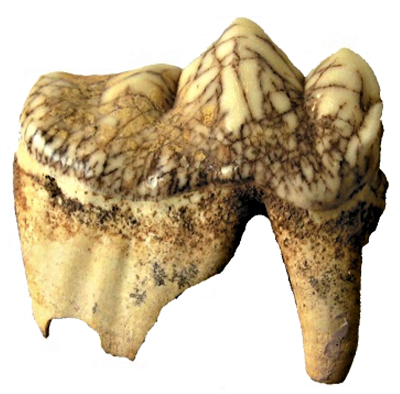
Upper Pleistocene molar tooth of spotted hyena from Wezmeh Cave, Iran.
Photo: Hiarash
Permission:
Creative Commons Attribution-Share Alike 4.0 International license.
Additional text: Wikipedia
Animal bones from Wezmeh on display at Zagros Palaeolithic Museum, Kermanshah, West Iran.
Zagros Paleolithic Museum (Persian: موزه پارینهسنگی زاگرس) is a museum in Kermanshah, Iran, established in 2008. The museum contains a large collection of stone tools and animal fossil bones from various Paleolithic sites in Iran. In Iran, it is the only museum of its kind.
The museum was established by Fereidoun Biglari and A. Moradi Bisetouni at Tekieh Biglar Baigi, Kermanshah in 2007. Marjan Mashkour, a zooarchaeologist, was in charge of animal fossil identification for the museum.
Photo: Courtesy Fereidoun Biglari, Head of the Palaeolithic Unit of the National Museum of Iran
Additional text: Wikipedia
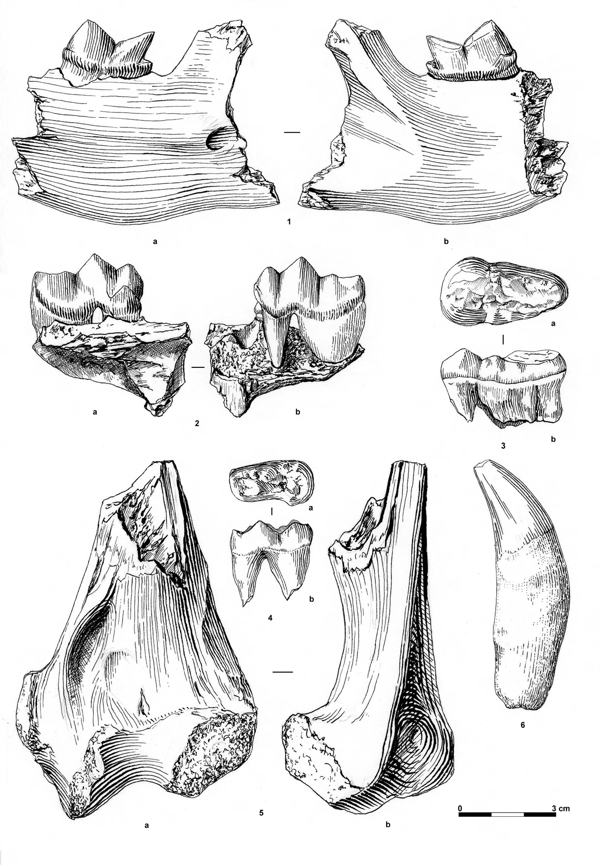
1–2. Crocuta crocuta
1: Mandible fragment with the lower carnassial M1 (WZ 1 dex.); a, lingual; b, labial.
2: Maxillary fragment with the upper carnassial M1 (WZ 1525 dex.); a, lingual; b, labial.
3–4. Ursus arctos
3: Upper M2 (WZ 100 dex.); a, occlusal, b, lingual.
4: Lower M1 (WZ 1595 sin.); a, occlusal; b, labial.
5–6. Panthera leo
5: Humerus distal (WZ 349 sin.); a, anterior; b, lateral.
6: Lower canine (WZ 486 dex.), lateral
Drawing: M. Ballinger
Source and text: Mashkour et al. (2009)
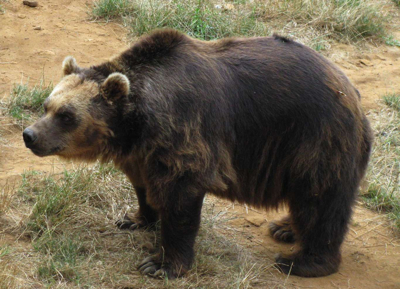
Brown bear, Ursus arctos
The bears at Le Regourdou are safely well below the visitors, and there is a wall to lean against. However there was an abiding sense of menace to the bears. I would not like to fall into the enclosure and be subject to their tender mercies.
Photo: Don Hitchcock 2008
Source: Le Regourdou Neanderthal site, Dordogne
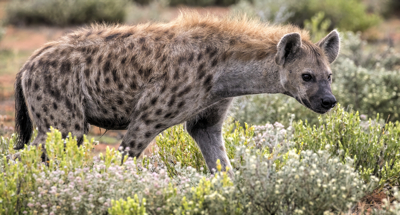
Spotted hyena, Crocuta crocuta.
Photo: Charles J Sharp
Permission: Creative Commons Attribution-Share Alike 4.0 International licence.
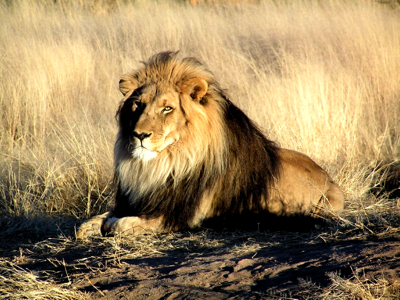
Lion, Panthera leo.
Photo: Kevin Pluck
Permission: Creative Commons Attribution 2.0 Generic licence.
| Age of some samples of fauna tested in Wezmeh Cave | ||||
|---|---|---|---|---|
| Sample | Species | Age (ky) | plus | minus |
| WZ 121 | Ursus arctos | 63.1 | 12.6 | 11.3 |
| WZ 474 | Ursus arctos | 70.5 | 6.8 | 6.4 |
| WZ 976 | Sus scrofa | 11.4 | 0.5 | 0.5 |
| WZ 19 | Crocuta crocuta | 14.1 | 0.7 | 0.7 |
| WZ 37 | Crocuta crocuta | 18.9 | 6.1 | 5.8 |
| WZ 10 | Crocuta crocuta | 43.2 | 3.5 | 3.4 |
Source for the table above: Mashkour et al. (2009)
References
- Abdi K., Biglari F., Heydari S., 2001: Test Excavations at Wezmeh Cave, January 2002, National Museum of Iran, https://www.researchgate.net/publication/290309627_Islamabad_Project_2001_Test_excavations_at_Wezmeh_Cave
- Biglari F., Mashkour M., Shidrang S., Rahmati M., Davoudi H., Mucheshi A.S., Taheri K., Samii S., Abdi K., 2021: Excavation at the Wezmeh Cave and survey of the surrounding area in the Qaziwand Mountains, The Islamabad Plain, Kermanshah, in: A Collection of Archaeological Finds From Excavations in 2019-2020, pp. 7-16, edited by Masoumeh Mosalla, 18th Annual Symposium on the Iranian Archaeology, Research Institute of Cultural Heritage & Tourism (RICHT), Tehran.
- Mashkour M., Monchot H., Trinkaus E., Reyss J., Biglari F., Bailon S., Heydari S., Abdi K., 2009: Carnivores and their Prey in the Wezmeh Cave (Kermanshah, Iran): A Late Pleistocene Refuge in the Zagros, International Journal of Osteoarchaeology, 19: 678–694 (2009) Published online 27 August 2008 in Wiley InterScience (www.interscience.wiley.com) DOI: 10.1002/oa.997
- Trinkaus E., Biglari F. et al., 2008: Late Pleistocene human remains from Wezmeh Cave, western Iran, American Journal of Physical Anthropology, 135(4):371-8 DOI: 10.1002/ajpa.20753
- Zanolli et al., 2019: Neanderthal from the Central Western Zagros, Iran. Structural reassessment of the Wezmeh 1 maxillary premolar, Journal of Human Evolution, Vol: 135.
